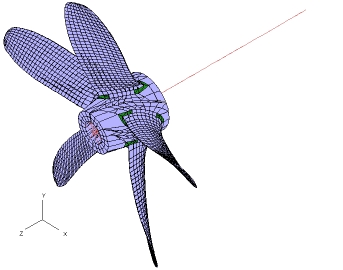Off-Axis Propeller Loads and Structural Response
PROPLOADS is a new CRS project to improve the prediction of propeller loads and structural response. In particular, PROPLOADS aims to improve the capability of PROCAL to predict off-axis loads and moments leading to a capability for predicting transient loads such as during maneuvering. The new WG will also provide a link between PROCAL and the CRS structural analysis software (Trident) to improve the prediction of structural response to loads through the propulsion chain including the propeller itself as well as the shafts, bearings, and brackets.
Backgrounds
Typically propeller loads and the resulting forces and moments they exert on the supporting structural elements such as shafts and bearings, are calculated in straight ahead conditions in calm water. While this will allow for the prediction of some lateral loads, there is a concern that there is a requirement to improve this prediction capability, particularly for a maneuvering vessel.
The CRS software tool PROCAL is a surface panel-based code for predicting propeller performance and some forms of propeller cavitation. While the code is capable of more than just open water predictions, there is a requirement to improve its ability to predict off-axis loads and moments. This would potentially allow for the prediction of loads while maneuvering (e.g. steady rudder angles).
On the ship platform side, there has also been a link produced between the hydrodynamic codes (such as PRECAL) and the structural response codes (now Trident) enabling the structural response to sealoads to be evaluated. There is no current analog on the propeller side. PROCAL can predict propeller loads, but the effect on the propeller structure itself or the supporting structure (shafts, bearings, etc.) can only be done by individual CRS members with their own tools. A CRS tool to generate the entire structural chain including the base support structure such as structural steel and bearings is desirable. This should improve the prediction of bearing loads and local structural response.

Objectives
The objectives of PROPLOADS are twofold – to improve the prediction of propeller loads, particularly while maneuvering, and to improve the prediction of propeller structural response. For the former, PROPLOADS will build on the improved PROCAL code produced in PROPDEV to improve the predictions of lateral vibration and improve shaft designs, and determine the forces and moments during transient manoeuvres. For the latter, PROPLOADS would provide a link between PROCAL and the CRS structural software Trident for geometry and loads. This would provide a capability to model the complete propeller (including hub), shaft, bearing supports, and any other supporting structure.

Expected Results
There will be three major thrusts in this project which are improving propeller loads predictions in simple maneuvers, improving structural response predictions, and performing full-scale validation work.
The project will attempt to enhance the predictive capability of PROCAL for manoeuvring by allowing a drift angle of the propeller wake with respect to the shaft centre line. This assumes PROCAL will be applied in a quasi-steady fashion so that any transient effects occur at a much larger time scale that one propeller revolution. A significant outcome would be improved predictions of lateral forces which could lead to improved predictions of structural loads (bearings, shafts, support structures), reduced structural damage, and improved propeller performance predictions in a variety of conditions.
As stated above, in the ship platform area of CRS, there is now a complete link from an existing sea state, through the hydrodynamic response of the ship, to the resulting structural loads and response through such working groups as STRUC, WHIP and ELAST. It is envisaged that a similar chain of computation could be made available on the propeller side of CRS. While structural modelling is well understood in general, the project will develop specialized methods for rapidly creating the associated structure for extended analysis of the complete propeller (including hub), shaft, bearing supports, and any other supporting structure. The goal for this task would be to complete the computational chain from the applied propeller loads to the resulting base structural loads on the ship.
For both tasks above, of serious concern is the lack of full-scale validation data. While some data from previous CRS projects may prove useful for the partial evaluation of the upgraded PROCAL, it is expected that a dedicated full-scale data set is required and will be obtained within this project. This would involve sea trials measuring the forces and moments both in a straight ahead configuration and with fixed rudder angles. Propeller viewing and perhaps even propeller structural response measurements may be required.
